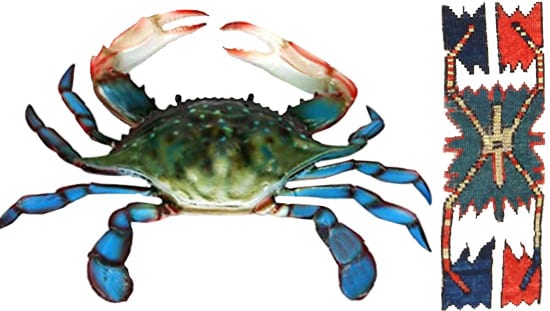The Crab Design Symbol: Its Long History and Significance
Click Here to Go Back to List of Symbols
Within the human spirit, there is something that seeks explanations for questions about life from Nature. In fact, many people are intrigued by the creatures who come from the ocean, that vast pool of energy and life. One of these creatures is the crab, whose appearance and habits are quite unique and meaningful.

A Real Crab Next A Crab Design Taken From An Antique Rug
The crab’s physical appearance, its nature, and its habitat have long been of interest to many who have attributed symbolic meaning to crabs. On ancient Peruvian pottery, for instance, there are paintings of a half-crab, half human rain forest deity. The crab design is also prominent in the creation myths of some African cultures and the cultures of Pacific island people. In China, the crab has long been perceived as a symbol of good luck and male potency when it is eaten.

Crab Design Rug Border
Significantly, because the crab emerges from the ocean, it is imagined as being ruled by the moon which controls the currents and tides. Also, because of its connection to the moon and, for some crabs ability to shed their old shell and generate a new one, the crab design has acted as a symbol of rebirth and renewal for many cultures. Many also feel that the crab symbolizes water’s power to bring peace and tranquility to a person’s life.

Crab Design Rug
The crab’s physical appearance also plays an essential role in the interpretation of it as a symbol. For instance, its hard shell is perceived as a symbol of protection. The sharp pincers it possesses are also part of its defense system as they allow the crab to fight against any attackers. In addition, its odd way of walking, meant to confuse predators, symbolizes the diversity of thought and creativity of this symbolic creature.
Indeed, many people feel that the symbolism of the crab teaches them to utilize their creativity and take diverse paths in their thinking about things. The symbolic crab design is truly significant because it reminds people that they exist in a world in which they will survive if they learn from this ocean creature the strength to sustain themselves and if they allow the crab’s example of diversity and creativity of thought to direct their actions.
Another name for the Crab design is Harshang. Though when people use the term “Harshang” to describe this pattern it looks a bit different from the more “structured” geometric approach.

Example of The Harshang Design
What is the history and meaning of the “harshang” / “crab” design in area rugs?
The “harshang” design, often referred to as the “crab” design in area rugs, is a distinctive and highly sought-after motif in Persian and Oriental rug weaving. This design features a central medallion with a repeating pattern of curvilinear, serrated leaves or vines radiating outward, resembling the legs or claws of a crab, hence the name “crab” design.
Here is some information about the history and meaning of the “harshang” or “crab” design in area rugs:
- Origin: The harshang design is believed to have originated in Persia (modern-day Iran) and can be found in antique rugs from various Persian rug-producing regions, including Heriz, Serapi, and Tabriz. It is a common motif in Persian tribal and village rugs.
- Symbolism: While the specific meaning of the harshang design may not have a universally recognized symbolic interpretation, it is generally appreciated for its aesthetic appeal. The curvilinear and repetitive nature of the design is often seen as a representation of the natural world and its harmonious patterns.
- Aesthetic Value: The harshang or crab design is known for its intricate and visually striking appearance. It often features a harmonious blend of colors, with a central medallion surrounded by a field filled with the crab-like motifs and intricate borders. The design is visually engaging and adds character to the rug.
- Collectability: Some of the antique and vintage rugs with the harshang design can be highly collectible and prized by rug enthusiasts and collectors. The complexity of the design, the quality of craftsmanship, and the age of the rug can all influence its value.
- Regional Variations: While the general concept of the harshang design remains consistent, there can be regional variations in how it is interpreted and woven. Different rug-weaving centers may incorporate unique color palettes, motifs, or border designs, adding diversity to the overall style.
In summary, the “harshang” or “crab” design in area rugs is a beautiful and distinctive motif that originated in Persian rug weaving. While it may not have a specific symbolic meaning, it is highly valued for its aesthetic appeal, craftsmanship, and collectability. The design is characterized by its central medallion and repeating crab-like motifs, and it has variations depending on the region in which it is produced.
Below are examples of antique rugs from Nazmiyal which incorporate the crab design:
Tribal Antique Northwest Persian Rug 49161

Antique Crab Design Northwest Persian Rug
Antique Tribal Northwest Persian Runner Rug 50669

Antique Tribal Crab Design Northwest Persian Runner Rug
